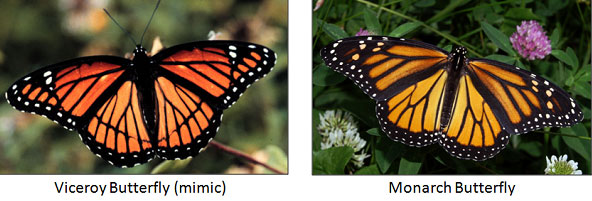
Have you ever noticed the variety of feet different species of birds have?

![]() The shape of a bird’s feet is an adaptation and can tell you a lot about where the bird lives and what it eats. Match the description to the correct bird foot.
The shape of a bird’s feet is an adaptation and can tell you a lot about where the bird lives and what it eats. Match the description to the correct bird foot.
Adaptations such as the structure of birds’ feet are physical adaptations. Other physical adaptations include body coloring and shape.
![]() Camouflage is one of the most common physical adaptations. Look closely at this picture of a leaf. Can you see the Baron caterpillar on the leaf? Click on the picture to see where the caterpillar is.
Camouflage is one of the most common physical adaptations. Look closely at this picture of a leaf. Can you see the Baron caterpillar on the leaf? Click on the picture to see where the caterpillar is.
Another example of a physical adaptation is mimicry. Mimicry is when an animal imitates another animal or object to avoid predators. Body shape as well as body color camouflages some animals. The insect commonly called a walking stick is an example of mimicry.
![]() Can you find the walking stick insect in this picture? Click on the picture to help you locate the insect.
Can you find the walking stick insect in this picture? Click on the picture to help you locate the insect.
Some animals’ body coloring warns predators that they are poisonous. Some animals that are not poisonous have body coloring that is very similar to a poisonous animal. This form of mimicry protects the nonpoisonous animal by tricking predators into thinking it is dangerous. The Viceroy Butterfly is nonpoisonous. Its coloring mimics the coloring of the Monarch Butterfly which is poisonous if eaten. It would be hard for a bird or frog to tell these two species apart.

Adaptations are inheritable characteristics that increase an organism's ability to survive and reproduce in an environment.
![]() Watch this short video that describes the adaptations of three different animals that live in three very different environments.
Watch this short video that describes the adaptations of three different animals that live in three very different environments.
Source: Animal Adaptations, lmiller23eion, YouTube
In your notes, list the adaptations that you learned about the camel, giraffe, and penguin. Check your answers below.
| Animal | Camel | Giraffe | Penguin |
| Picture |  |
 |
 |
| Location |
Interactive button. Assistance may be required.
Desert |
Interactive button. Assistance may be required.
Savanah - Grassland |
Interactive button. Assistance may be required.
Artic - Tundra |
| Adaptations |
Interactive button. Assistance may be required.
|
Interactive button. Assistance may be required.
|
Interactive button. Assistance may be required.
|
Sources for images used in this section, as they appear, top to bottom: